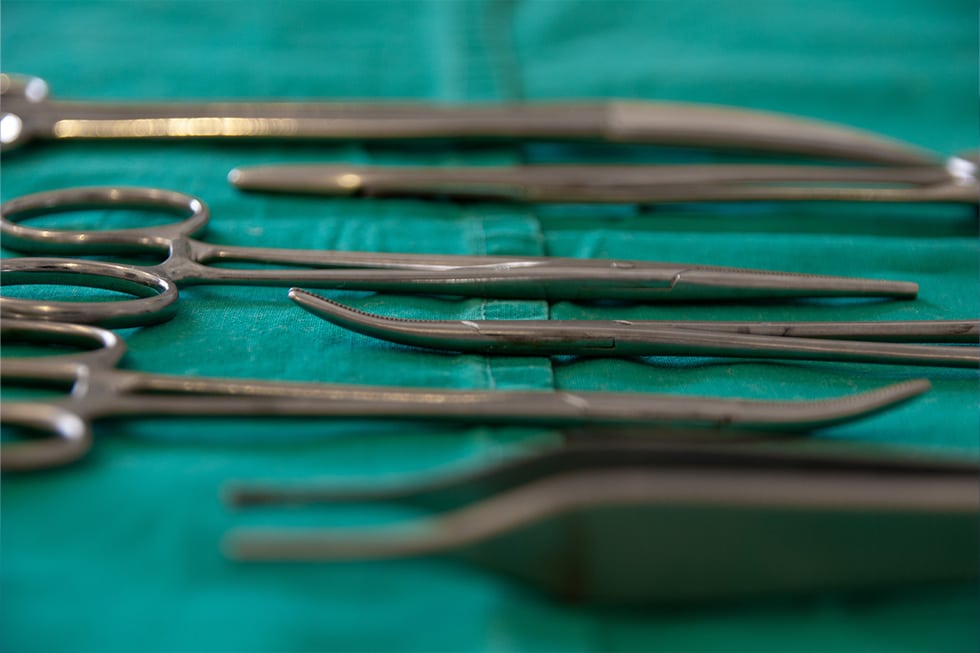
Two factors must be considered regarding the effectiveness of medical instruments. The first requirement is that they meet their design specifications. Their shape, size, sharpness, etc. must be exactly as expected or their functionality can be impaired. In some instances, a medical instrument can be rendered unusable as a result of even the smallest of deviations.
For that reason, special care has to be taken when applying advanced chromium coatings to instruments. The material must be exceptionally strong even when applied in extremely thin layers. Thicknesses ranging from 0.00004” to 0.001” per side (1.0-25.0 microns) are often needed.
The second factor affecting medical instrument effectiveness is one many people might dismiss: appearance. Items that become stained and discolored not only erode the confidence of the medical professionals who use them, they can also cause concern in patients and their families.

Serious Consequences from Simple Discoloration in Stained Medical Instruments
Discolored and stained medical instruments do more than simply raise eyebrows among medical teams and patients. For one, if the problem persists and becomes widely known, it can damage a provider’s industry reputation. And that, of course, can hurt the business. If a patient must choose between two medical providers, they are likely to avoid the one flagged for stained instruments. Most would opt for the hospital or doctor’s office with a cleaner reputation.
Another serious consequence of failing to address instrument aesthetics is that it can result in a temporary halt in procedures. The presence of stains or discoloration on instruments does not necessarily indicate it is unsterile or a potential source of healthcare-acquired infections. However, it may prompt officials or healthcare facilities to cancel elective procedures while investigating the issue. With elective procedures being a major source of revenue for many healthcare organizations, even a short stoppage can have serious financial ramifications.
What Causes Medical Instrument Discoloration?
There are multiple reasons that a medical instrument can become stained, including exposure to bodily fluids and chemicals during procedures. One of the most common causes of discoloration is poor steam quality in the sterilization process. It also includes the accumulation of calcium and magnesium on instrument surfaces.
Poor steam quality typically can be resolved by repairing or replacing the sterilization unit. However, it is important to give medical instruments a “first line of defense” from staining and discoloration from any cause, and there is a way to do that effectively.
How Can Medical Instruments Be Protected From Discoloration?
The best way to protect medical instruments from staining and discoloration—and all of the negative effects it can have on a hospital, clinic, or doctor’s office—is to apply an advanced coating to them. Often this is a biocompatible chromium material that provides outstanding protection and is still safe to come into contact with the human body.
ME-92®, for example, has incredibly high surface hardness and is both anti-microbial and hydrophobic. As a result, it can prevent bioburden on instruments and enable items to withstand many hundreds of cleaning and autoclave sterilization cycles without staining or discoloration. The coating simply does not give any materials that an instrument comes into contact with the ability to adhere or cause a reaction that produces discoloration.
An added benefit of coating medical instruments in an ultra-thin layer of chromium is that the material helps prevent wear. Consequently, devices perform exactly as they were intended for much longer than uncoated instruments. This means that healthcare providers can spend less time and money on replacing instruments. In the wake of the COVID-19 pandemic, the increased longevity of medical instruments also means that providers are not as subject to the supply chain disruption that is affecting so many industries today (or any future disruptions that may occur).
Appearance Matters
No question about it—a medical instrument’s performance must be a designer, manufacturer, and user’s top priority. But an item’s appearance is not something that can be ignored. Fortunately, advanced chromium coatings like ME-92® can address both requirements. Those are, helping instruments function better longer while also maintaining a like-new look that inspires confidence in medical teams, patients, and families alike.
And stakeholders that research advanced chromium coatings find they are cost-effective. What’s more, they find a company like ME-92 Operations can apply coatings quickly and efficiently. Whether a designer needs a coating for a small number of prototype instruments, a manufacturer needs to coat large production runs, or a healthcare provider decides to coat instruments that are already being used, those requests can be handled with ease.